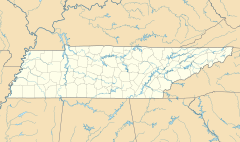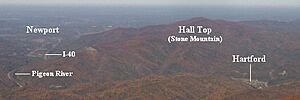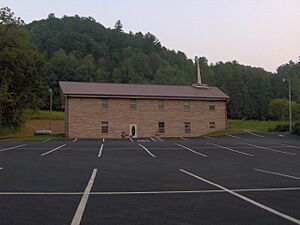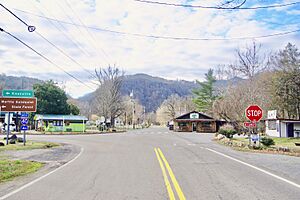Hartford, Tennessee facts for kids
Quick facts for kids
Hartford, Tennessee
|
|
|---|---|
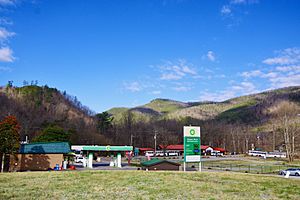
Businesses in Hartford
|
|
| Country | United States |
| State | Tennessee |
| County | Cocke |
| Elevation | 1,263 ft (385 m) |
| Population
(2000)
|
|
| • Total | 814 |
| Time zone | UTC-5 (Eastern (EST)) |
| • Summer (DST) | UTC-4 (EDT) |
| ZIP codes |
37753
|
| GNIS feature ID | 1328398 |
Hartford is a small, unincorporated community in Cocke County, Tennessee. This means it's a recognized place but doesn't have its own local government like a city or town. In 2000, about 814 people lived in the area that Hartford serves.
Hartford is special because it's the easternmost community in Tennessee along Interstate 40. It's like the "gateway" to the state for travelers coming from the east. The community is located right at the edge of the Great Smoky Mountains and is part of the Cherokee National Forest.
Contents
Life in Hartford
In 2000, there were 814 people living in the Hartford area. Most people living here were White. About 27% of the households had children under 18 living with them. The average household had about 2 to 3 people.
The population was almost evenly split between males and females. The average age of people in Hartford was about 40 years old.
Hartford's Location
Hartford is located at 35°49′0″N 83°8′36″W / 35.81667°N 83.14333°W. The community sits in a narrow valley next to the Pigeon River. This river flows from high up in the Blue Ridge Mountains down into the flatter areas of Cocke County. The river's valley separates the tall peaks of the Great Smokies to the southwest from the Snowbird mountain range to the northeast.
Hartford is surrounded by mountains. Snowbird Mountain rises about 4,200 feet to the east. Mount Cammerer, which is the easternmost part of the Great Smokies, rises almost 5,000 feet to the south. To the west, the Foothills Parkway crosses Green Mountain, connecting the Pigeon Valley to Cosby, Tennessee. Stone Mountain, also known as Hall Top, is a major feature to the north.
Interstate 40 passes right through Hartford, following the Pigeon River Valley. This highway connects Hartford to Knoxville, Tennessee to the west and Asheville, North Carolina to the east.
Hartford's Past
The first known permanent settler in the Hartford area was Solomon Williams, who arrived in 1853. Soon after, Moses Clark donated land for a log meeting house. For most of the 1800s, this building was used for church services and as a school. During this time, the community was simply called Pigeon Valley. Hartford's Pigeon Valley Church, which began in 1889, still uses the old name.
Like many communities in Appalachia, Pigeon Valley grew a lot during the logging boom in the late 1800s. New tools like the band saw and a high demand for wood made lumber companies look to the thick forests of the Appalachian Mountains. The Scottish-Carolina Timber and Land Company was one of the first to cut trees in the Pigeon Valley area. They floated the logs down the river to a factory in Newport. This factory used the tree bark to help make leather. This logging business lasted about six years. In 1886, a huge flood on the Pigeon River washed away the company's logs, and they had to close down.
Early 1900s Changes
Pigeon Valley was renamed "Hartford" to honor John Hart. He was a co-owner of the Tennessee & North Carolina Railroad and oversaw the building of a train line through the valley. This line connected Newport and Waterville.
In 1917, the Boice Hardwood Company built a large sawmill in Hartford. They planned to cut down trees along the river's north bank all the way to Max Patch Mountain. Hartford quickly became a "company town," meaning it grew up around the sawmill. Mary Bell Smith, who lived in Hartford back then, remembered:
Every morning Hartford came to life at five o'clock with the shrill whistle from the sawmill that signaled the new day. Before dawn, the big steam boiler began belching out the steam which operated the sawmill for another day. The bandsaw hummed, the cut-off saw screeched, and the drag-chain rumbled as it carried trash, cull lumber, and sawdust up the conveyor to the blazing furnace.
As the mill did well in the 1920s, Hartford grew to include several houses, a general store, a post office, a school, and even a movie theater. The sawmill's generators even provided electricity to the town from 5 AM to 10 PM. People also continued to join the old Pigeon Valley Church. Smith remembered a baptism that happened in the middle of winter in 1925:
At two o'clock that Sunday afternoon, Rev. Hall walked into the Pigeon River, pushing away mushy ice as he walked. Wading far enough out into the river for the water to reach about waist high, he prepared himself for the baptismal service. We spectators watched with steamy breath from the river banks as the newly converted believers were momentarily buried in the icy waters.
When the Great Depression started in the early 1930s, the demand for timber disappeared. Boice Hardwood had to close. Hartford's economy didn't really get better until Interstate 40 was built through the town in the 1960s.
Hartford Today
Today, Hartford is one of the few places to stop for gas and food along the 60-mile stretch of I-40 between Newport and Waynesville, North Carolina. Hartford has also become popular with people who love whitewater rafting. This is because the Pigeon River flows quickly through the area. The Martha Sundquist State Forest is also located close to Hartford.
Education in Hartford
The only school in Hartford is Grassy Fork Elementary School. It serves students from kindergarten through eighth grade. For high school, most students go to Cosby High School in nearby Cosby, or Cocke County High School in Newport.


